Analys
OPEC poised to scrap Q4 production hike

As of mid-August, Brent crude oil has experienced a USD 5 per barrel (6.5%) increase in price since the low point on August 5th, currently trading at USD 80.3 per barrel, and remaining relatively unchanged from Monday’s opening.

As previously noted, the OPEC+ Joint Ministerial Monitoring Committee (JMMC) did not make any new recommendations at their meeting on August 1st. Specifically, a planned production increase of 2.2 million barrels per day is set to be gradually implemented from Q4 2024 through Q3 2025. However, despite this being the current OPEC base case, it is subject to significant uncertainties. If market conditions do not favor OPEC, the production increase may not materialize.
This week, the International Energy Agency (IEA) indicated that global oil markets could shift from a deficit to a surplus in Q4 2024 if OPEC+ proceeds with the aforementioned plan. This is not surprising and aligns with the consensus view; however, the plan is far from certain and should be taken with a grain of salt.
Global oil and product inventories have significantly depleted during peak summer demand. Yet, the recent drawdowns have been larger than expected: Yesterday, U.S. gasoline inventories decreased by 2.9 million barrels (3% below the five-year average), and distillate (diesel) inventories dropped by 1.7 million barrels (7% below the five-year average). Consequently, total commercial petroleum inventories decreased by 3.1 million barrels last week, which is counter-seasonal when compared with the 2015-2021 average.
As we exit the Northern hemisphere peak demand period, and assuming crude and product inventories stabilize according to seasonal patterns, a potential production increase from OPEC+ in October could lead to an oversupply.
Additionally, there is slowing demand growth in China, the world’s largest importer. Therefore, we believe that the OPEC+ plan, led by Saudi Arabia and Russia, to gradually increase production by 543,000 barrels per day in the fourth quarter will likely be adjusted or even scrapped. At present, there is no room for these additional volumes.
Brent crude continues to hover around USD 80 per barrel. A production increase from OPEC+ would likely cause prices to plummet to USD 60-70 per barrel overnight, which is well below the cartel’s ideal price range of USD 80-90 per barrel.
Furthermore, recent price volatility has increased due to conflicting factors. On one hand, relatively strong summer demand and heightened geopolitical tensions have pushed prices up, while on the other, weak economic growth in China has exerted downward pressure.
As a result, OPEC recently lowered its 2024 demand growth forecast due to weaker Chinese demand. However, it still projects growth rates more than double those estimated by the IEA, which expects global oil consumption to rise by about 1% annually, reaching 103.06 million barrels per day in 2024. This projection considers economic challenges and the ongoing shift to electric vehicles.
Another downside risk is the current positioning of managed money in petroleum futures, which suggests a bearish outlook, as highlighted by McGlone. A potential mean reversion in the stock market could be a critical factor when comparing crude oil to the S&P 500 Beta.
Petroleum speculators are nearing their most bearish stance, coinciding with the S&P 500 retreating from a 26% surge above its 100-week moving average in July (see pages 5-8 attached).
Historically, crude oil tends to decline when the S&P 500 Beta does. Over the past 25 years, the only instance where the S&P 500 maintained a level above a 26% premium to its mean for more than a few weeks was during the unprecedented monetary expansion in 2021, which may signal a forthcoming correction.
A continued and typical reversion in Beta could apply downward pressure on both WTI and Brent crude. Since 2011, petroleum speculators have averaged a 13% net-long position, with the lowest point being 4.4% in 2020.
This does not imply a negative outlook on the price curve. Our target for Brent crude is USD 85 per barrel in 2024. Year-to-date, the price has averaged USD 83.2 per barrel. Price distribution within a year typically varies by USD 15 per barrel from the mean. Therefore, we could see prices as high as USD 100 per barrel and as low as USD 70 per barrel. In very general terms, USD 70 per barrel could be seen at some point this year purely due to statistical fluctuations. This might occur in the coming weeks or months, as the latest market scare—though not a recession—resembles a correction that may still have more to play out. Additionally, ongoing uncertainty regarding the OPEC+ strategy continues to affect the market.
However, current market fundamentals suggest that OPEC+ is unlikely to increase production in the fourth quarter. Combined with increasing macroeconomic uncertainty, we remain confident in our Brent crude price direction and recommend continuing to buy at lower/mid USD 70 per barrel in the short term, reaffirming our positive outlook for Brent crude.
Analys
More weakness and lower price levels ahead, but the world won’t drown in oil in 2026

Some rebound but not much. Brent crude rebounded 1.5% yesterday to $65.47/b. This morning it is inching 0.2% up to $65.6/b. The lowest close last week was on Thursday at $64.11/b.

The curve structure is almost as week as it was before the weekend. The rebound we now have gotten post the message from OPEC+ over the weekend is to a large degree a rebound along the curve rather than much strengthening at the front-end of the curve. That part of the curve structure is almost as weak as it was last Thursday.
We are still on a weakening path. The message from OPEC+ over the weekend was we are still on a weakening path with rising supply from the group. It is just not as rapidly weakening as was feared ahead of the weekend when a quota hike of 500 kb/d/mth for November was discussed.
The Brent curve is on its way to full contango with Brent dipping into the $50ies/b. Thus the ongoing weakening we have had in the crude curve since the start of the year, and especially since early June, will continue until the Brent crude oil forward curve is in full contango along with visibly rising US and OECD oil inventories. The front-month Brent contract will then flip down towards the $60/b-line and below into the $50ies/b.
At what point will OPEC+ turn to cuts? The big question then becomes: When will OPEC+ turn around to make some cuts? At what (price) point will they choose to stabilize the market? Because for sure they will. Higher oil inventories, some more shedding of drilling rigs in US shale and Brent into the 50ies somewhere is probably where the group will step in.
There is nothing we have seen from the group so far which indicates that they will close their eyes, let the world drown in oil and the oil price crash to $40/b or below.
The message from OPEC+ is also about balance and stability. The world won’t drown in oil in 2026. The message from the group as far as we manage to interpret it is twofold: 1) Taking back market share which requires a lower price for non-OPEC+ to back off a bit, and 2) Oil market stability and balance. It is not just about 1. Thus fretting about how we are all going to drown in oil in 2026 is totally off the mark by just focusing on point 1.
When to buy cal 2026? Before Christmas when Brent hits $55/b and before OPEC+ holds its last meeting of the year which is likely to be in early December.
Brent crude oil prices have rebounded a bit along the forward curve. Not much strengthening in the structure of the curve. The front-end backwardation is not much stronger today than on its weakest level so far this year which was on Thursday last week.

The front-end backwardation fell to its weakest level so far this year on Thursday last week. A slight pickup yesterday and today, but still very close to the weakest year to date. More oil from OPEC+ in the coming months and softer demand and rising inventories. We are heading for yet softer levels.

Analys
A sharp weakening at the core of the oil market: The Dubai curve

Down to the lowest since early May. Brent crude has fallen sharply the latest four days. It closed at USD 64.11/b yesterday which is the lowest since early May. It is staging a 1.3% rebound this morning along with gains in both equities and industrial metals with an added touch of support from a softer USD on top.

What stands out the most to us this week is the collapse in the Dubai one to three months time-spread.
Dubai is medium sour crude. OPEC+ is in general medium sour crude production. Asian refineries are predominantly designed to process medium sour crude. So Dubai is the real measure of the balance between OPEC+ holding back or not versus Asian oil demand for consumption and stock building.
A sharp weakening of the front-end of the Dubai curve. The front-end of the Dubai crude curve has been holding out very solidly throughout this summer while the front-end of the Brent and WTI curves have been steadily softening. But the strength in the Dubai curve in our view was carrying the crude oil market in general. A source of strength in the crude oil market. The core of the strength.
The now finally sharp decline of the front-end of the Dubai crude curve is thus a strong shift. Weakness in the Dubai crude marker is weakness in the core of the oil market. The core which has helped to hold the oil market elevated.
Facts supports the weakening. Add in facts of Iraq lifting production from Kurdistan through Turkey. Saudi Arabia lifting production to 10 mb/d in September (normal production level) and lifting exports as well as domestic demand for oil for power for air con is fading along with summer heat. Add also in counter seasonal rise in US crude and product stocks last week. US oil stocks usually decline by 1.3 mb/week this time of year. Last week they instead rose 6.4 mb/week (+7.2 mb if including SPR). Total US commercial oil stocks are now only 2.1 mb below the 2015-19 seasonal average. US oil stocks normally decline from now to Christmas. If they instead continue to rise, then it will be strongly counter seasonal rise and will create a very strong bearish pressure on oil prices.
Will OPEC+ lift its voluntary quotas by zero, 137 kb/d, 500 kb/d or 1.5 mb/d? On Sunday of course OPEC+ will decide on how much to unwind of the remaining 1.5 mb/d of voluntary quotas for November. Will it be 137 kb/d yet again as for October? Will it be 500 kb/d as was talked about earlier this week? Or will it be a full unwind in one go of 1.5 mb/d? We think most likely now it will be at least 500 kb/d and possibly a full unwind. We discussed this in a not earlier this week: ”500 kb/d of voluntary quotas in October. But a full unwind of 1.5 mb/d”
The strength in the front-end of the Dubai curve held out through summer while Brent and WTI curve structures weakened steadily. That core strength helped to keep flat crude oil prices elevated close to the 70-line. Now also the Dubai curve has given in.
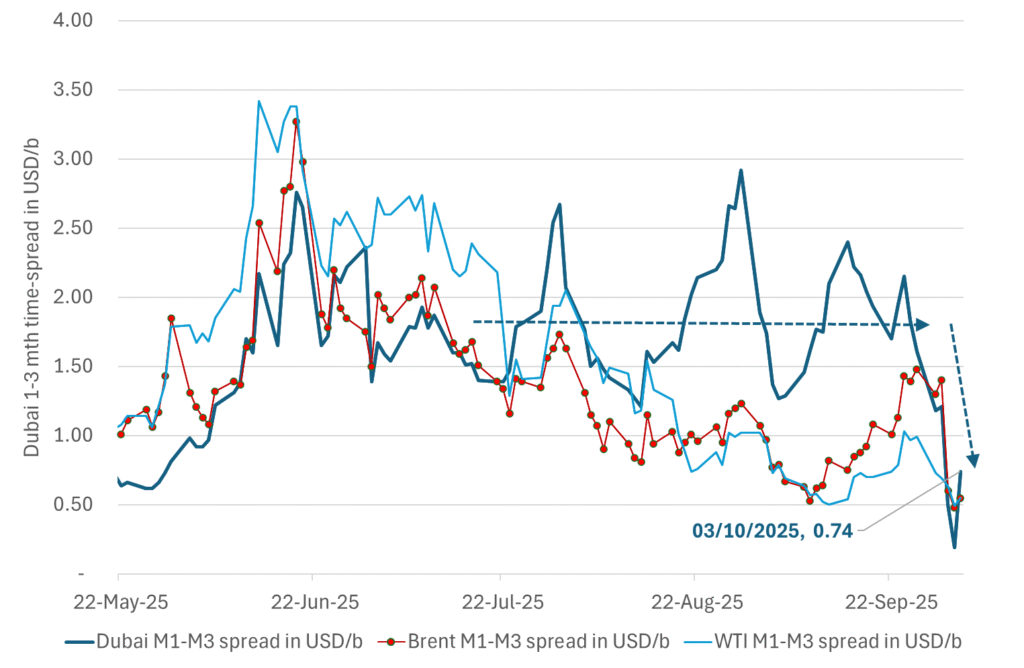
Brent crude oil forward curves

Total US commercial stocks now close to normal. Counter seasonal rise last week. Rest of year?
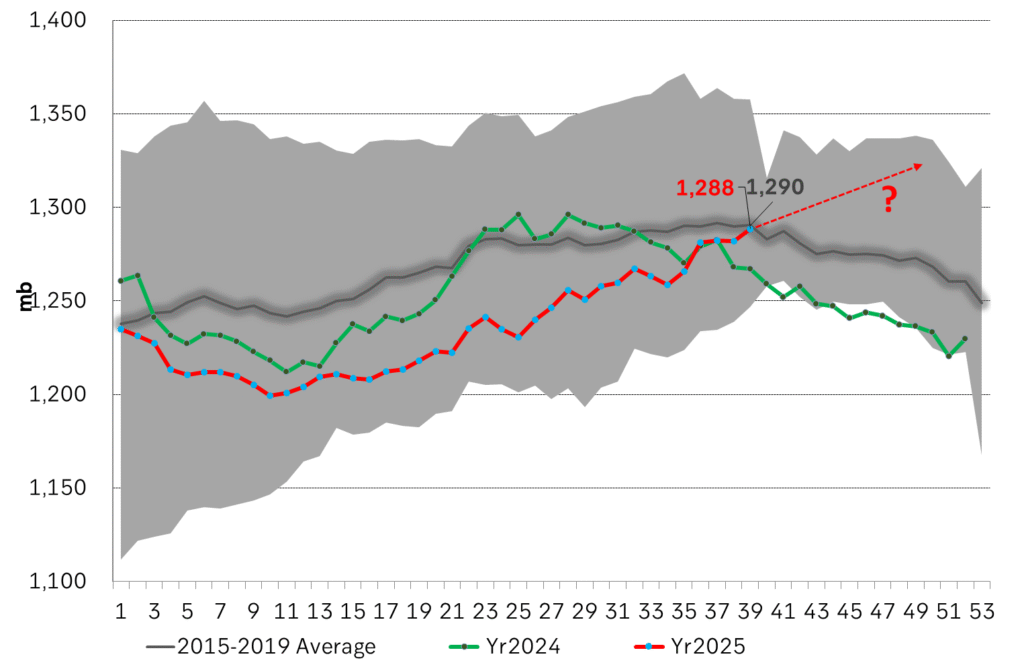
Total US crude and product stocks on a steady trend higher.
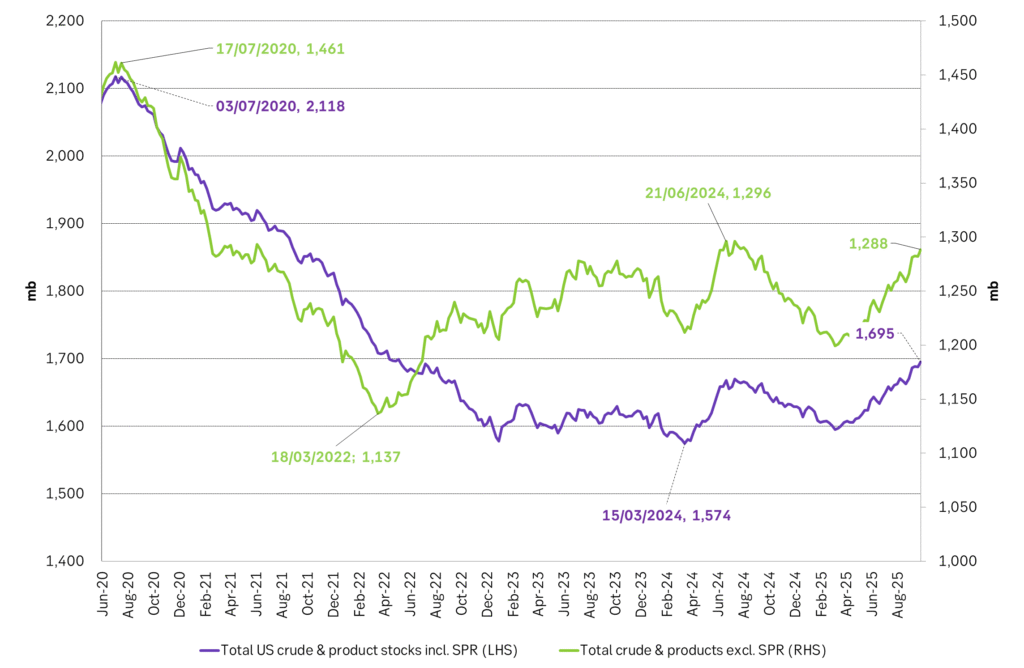
Analys
OPEC+ will likely unwind 500 kb/d of voluntary quotas in October. But a full unwind of 1.5 mb/d in one go could be in the cards

Down to mid-60ies as Iraq lifts production while Saudi may be tired of voluntary cut frugality. The Brent December contract dropped 1.6% yesterday to USD 66.03/b. This morning it is down another 0.3% to USD 65.8/b. The drop in the price came on the back of the combined news that Iraq has resumed 190 kb/d of production in Kurdistan with exports through Turkey while OPEC+ delegates send signals that the group will unwind the remaining 1.65 mb/d (less the 137 kb/d in October) of voluntary cuts at a pace of 500 kb/d per month pace.

Signals of accelerated unwind and Iraqi increase may be connected. Russia, Kazakhstan and Iraq were main offenders versus the voluntary quotas they had agreed to follow. Russia had a production ’debt’ (cumulative overproduction versus quota) of close to 90 mb in March this year while Kazakhstan had a ’debt’ of about 60 mb and the same for Iraq. This apparently made Saudi Arabia angry this spring. Why should Saudi Arabia hold back if the other voluntary cutters were just freeriding? Thus the sudden rapid unwinding of voluntary cuts. That is at least one angle of explanations for the accelerated unwinding.
If the offenders with production debts then refrained from lifting production as the voluntary cuts were rapidly unwinded, then they could ’pay back’ their ’debts’ as they would under-produce versus the new and steadily higher quotas.
Forget about Kazakhstan. Its production was just too far above the quotas with no hope that the country would hold back production due to cross-ownership of oil assets by international oil companies. But Russia and Iraq should be able to do it.
Iraqi cumulative overproduction versus quotas could reach 85-90 mb in October. Iraq has however steadily continued to overproduce by 3-5 mb per month. In July its new and gradually higher quota came close to equal with a cumulative overproduction of only 0.6 mb that month. In August again however its production had an overshoot of 100 kb/d or 3.1 mb for the month. Its cumulative production debt had then risen to close to 80 mb. We don’t know for September yet. But looking at October we now know that its production will likely average close to 4.5 mb/d due to the revival of 190 kb/d of production in Kurdistan. Its quota however will only be 4.24 mb/d. Its overproduction in October will thus likely be around 250 kb/d above its quota with its production debt rising another 7-8 mb to a total of close to 90 mb.
Again, why should Saudi Arabia be frugal while Iraq is freeriding. Better to get rid of the voluntary quotas as quickly as possible and then start all over with clean sheets.
Unwinding the remaining 1.513 mb/d in one go in October? If OPEC+ unwinds the remaining 1.513 mb/d of voluntary cuts in one big go in October, then Iraq’s quota will be around 4.4 mb/d for October versus its likely production of close to 4.5 mb/d for the coming month..
OPEC+ should thus unwind the remaining 1.513 mb/d (1.65 – 0.137 mb/d) in one go for October in order for the quota of Iraq to be able to keep track with Iraq’s actual production increase.
October 5 will show how it plays out. But a quota unwind of at least 500 kb/d for Oct seems likely. An overall increase of at least 500 kb/d in the voluntary quota for October looks likely. But it could be the whole 1.513 mb/d in one go. If the increase in the quota is ’only’ 500 kb/d then Iraqi cumulative production will still rise by 5.7 mb to a total of 85 mb in October.
Iraqi production debt versus quotas will likely rise by 5.7 mb in October if OPEC+ only lifts the overall quota by 500 kb/d in October. Here assuming historical production debt did not rise in September. That Iraq lifts its production by 190 kb/d in October to 4.47 mb/d (August level + 190 kb/d) and that OPEC+ unwinds 500 kb/d of the remining quotas in October when they decide on this on 5 October.
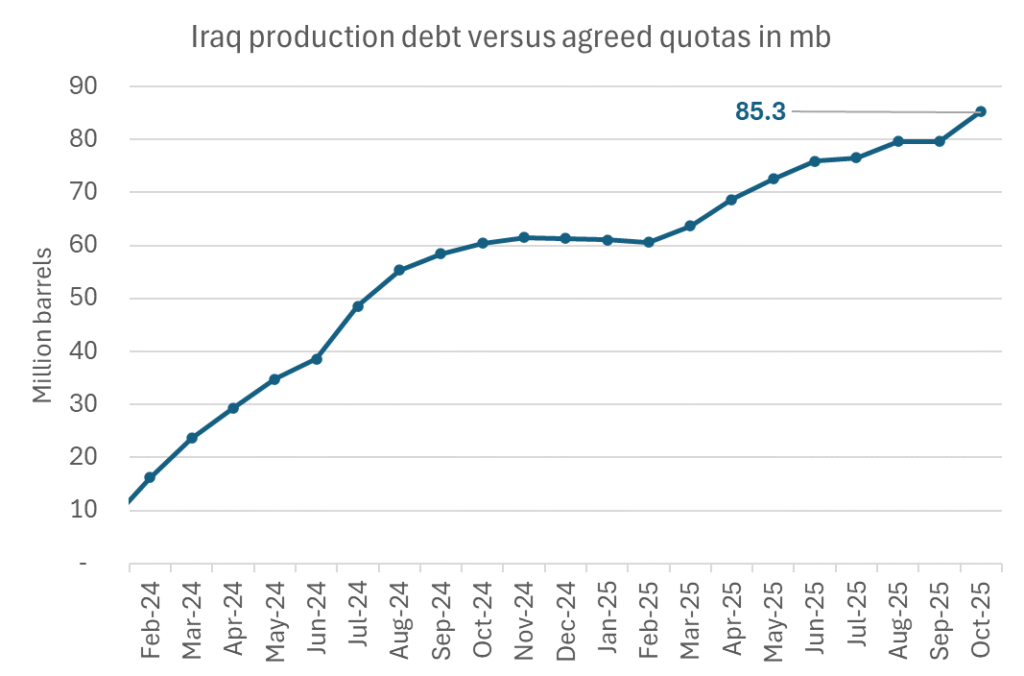
-

 Nyheter4 veckor sedan
Nyheter4 veckor sedanMahvie Minerals i en guldtrend
-

 Analys4 veckor sedan
Analys4 veckor sedanVolatile but going nowhere. Brent crude circles USD 66 as market weighs surplus vs risk
-
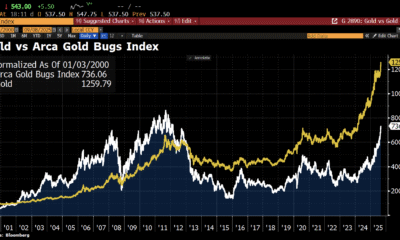
 Nyheter4 veckor sedan
Nyheter4 veckor sedanAktier i guldbolag laggar priset på guld
-

 Nyheter4 veckor sedan
Nyheter4 veckor sedanKinas elproduktion slog nytt rekord i augusti, vilket även kolkraft gjorde
-

 Nyheter4 veckor sedan
Nyheter4 veckor sedanTyskland har så höga elpriser att företag inte har råd att använda elektricitet
-
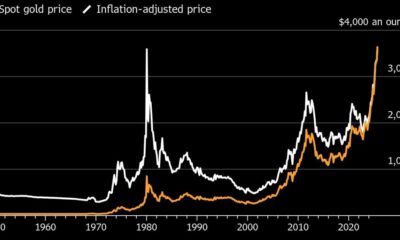
 Nyheter4 veckor sedan
Nyheter4 veckor sedanGuld når sin högsta nivå någonsin, nu även justerat för inflation
-
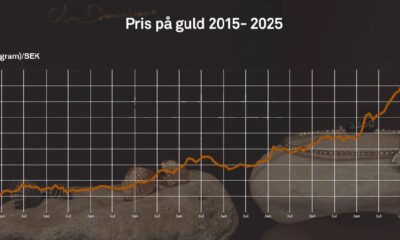
 Nyheter4 veckor sedan
Nyheter4 veckor sedanDet stigande guldpriset en utmaning för smyckesköpare
-

 Analys4 veckor sedan
Analys4 veckor sedanBrent crude ticks higher on tension, but market structure stays soft








